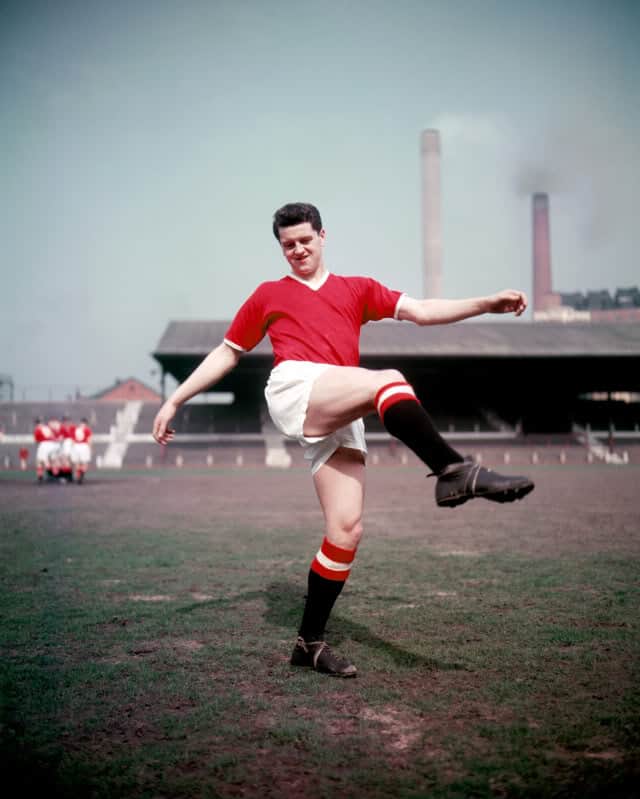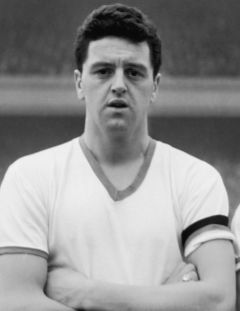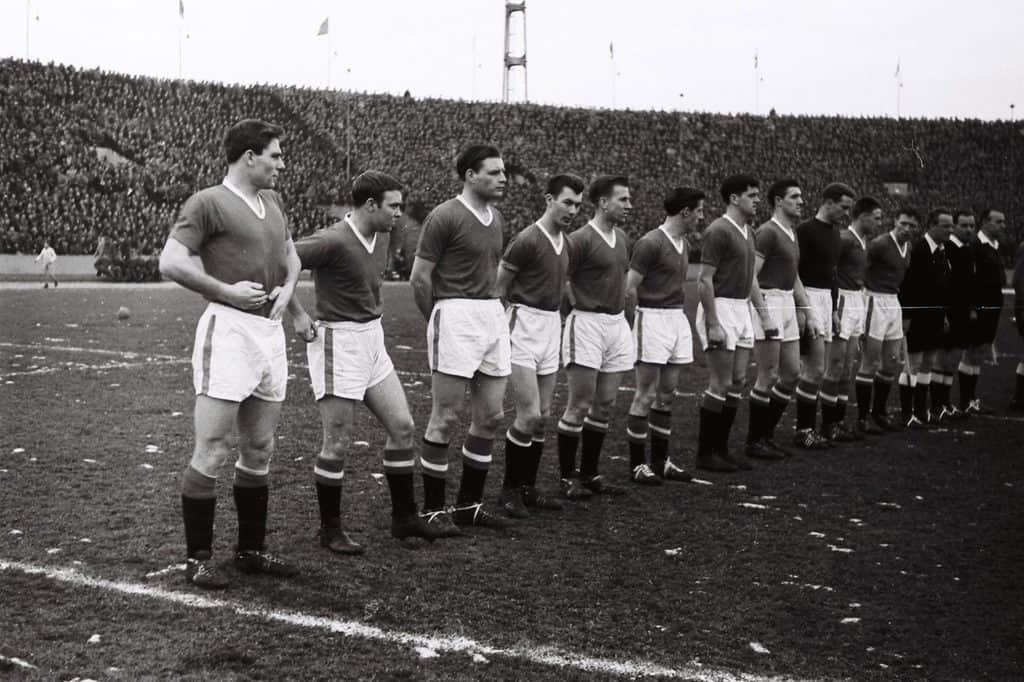
Brian Hughes regards Tommy Taylor as perhaps the greatest center-forward of all time. He was motivated to write this book by his feeling that Taylor was often overlooked when great players of the past were being discussed. This was partly due to Taylor’s tragic and untimely death in the Munich air crash, but nonetheless, Hughes does an excellent job of setting the record straight and putting the case for his hero. The book is never less than interesting, containing a remarkable range of quotations from Taylor himself alongside the thoughts of numerous high-profile contemporaries.
In the Introduction, Hughes states that he was keen to reflect both the good and bad of Taylor, in order to give a complete picture of the man. Nonetheless, it would be as well not to get too excited if you are reading the book with the hope of discovering any dark secrets about the popular Yorkshireman, as the worst things you will discover are that he may once have fouled a player off the ball, and he kissed a woman who was not his fiancee on a night out. The book is an affectionate portrait of a figure who perhaps deserves a higher profile, and it is no less entertaining for that. Occasionally quotes contradict one another slightly, and details of Taylor’s personal life during his playing career are few and far between, with his fiancee not even directly mentioned, but overall Hughes’ book is an enjoyable read. It covers ground that few people will be familiar with these days, and offers a rare insight into British football in the 1940s and 1950s.
Tommy Taylor was born on 29 January 1932 in the Smithies area of Barnsley, to Charles and Violet Taylor. He was the fifth of their six children. Hughes describes Taylor as a friendly lad with a mischievous smile. Tommy was soon nicknamed ‘Tucker’ after the nursery rhyme character, although schoolmate Dickie Bird felt that this might have been due to his proficiency in tucking away goals! After attending Burton Road Junior School, Taylor, who was an average student, moved on to Raley Secondary Modern. Raley was not a particularly academic establishment, but it had a good reputation for sport and was relatively well equipped for the time, featuring sports pitches, a swimming pool, and a gymnasium. This emphasis clearly helped Taylor progress towards a sporting career, as did the fact that both his grandfather and father had played football at a decent level.
Hughes describes how Taylor enjoyed spending time outdoors with his friends after school, sometimes playing football, but engaging in other activities like swimming too. The stories of his school days are a little contradictory, but what is clear is that Tommy was not as dedicated to football as he would later become. Despite being selected for the school team and Barnsley Boys, he did not even own a pair of boots of his own, borrowing a pair from a friend when possible. Eventually, he was barred from the school team for twice turning up for matches with just a pair of clogs for footwear. Hughes suggests that Tommy was not keen to commit to after school activities, preferring to spend time with his friends, although the lack of boots could have been due to financial issues during the difficult post-war years. Whatever the truth of the situation, Taylor only made a limited number of competitive appearances during his school days, and eventually left school at 14 to work at the local pit as a surface worker.
Taylor’s parents were keen to see him do well in football, and, according to the man himself, always made sure he had the ‘proper kit’, which makes his lack of boots all the more puzzling. What is not in doubt is that coaching was very limited during Tommy’s schooldays, so youngsters would work on their technique independently. Despite the fact that he was clearly talented, although still on the small side at this point, for around two years from the age of 14 Taylor had little interest in playing football seriously, and spent his leisure time with his friends, just enjoying the occasional kickabout. When he was 16, Tommy got back into football by chance when a local team named Smithies United found themselves a man short. He stepped in and did well, and, after just three games, scouts from Hull City and Barnsley were keenly watching him. Both quickly made an offer, but Barnsley got in first and Tommy was pleased to sign, initially as an amateur. He is quoted as saying that the enthusiasm of the clubs fired his ambition, and he found it hard to see why he had lost interest in the game previously. A transfer fee of £10 was paid to Smithies, and in July 1949 Taylor signed professional forms at Oakwell.
One of the most compelling aspects of Hughes’ book is the inclusion of many descriptions of the physique and playing style of Taylor. It is this element which helps the reader to visualize what the man was like to watch, and indeed to play against. By all accounts, he was not the fittest or the biggest when he began his career at Barnsley, but the descriptions of his ability already emphasize some of the strengths which would define his career at Manchester United. From the beginning, Taylor was enthusiastic in training and a ready listener. He was strong and could strike the ball well with either foot. There is one characteristic which is mentioned repeatedly, however, and which seems to be something everyone who watched him remembers: he could jump extremely high and seemingly hang in the air, making him an outstanding header of a ball.

Once Taylor began to establish himself at Barnsley, fans, and coaches quickly recognized that he was a special talent. Nonetheless, his career was soon to be interrupted by National Service, which meant two years in the Royal Artillery. He was released for some games during this period, but his appearances were necessarily sporadic. Coming so soon after two years out of the game, it might have been thought that this period would represent a major setback for the young Yorkshireman, but, as Hughes explains, in many ways this actually worked to his benefit. Taylor enjoyed the discipline of army life and played football at a good standard for various army teams, both at home and abroad. Most importantly, the training made him fitter and stronger, and he actually grew two inches taller during this period too, so he became a far more physically imposing figure than he had been before.
The downside of Taylor’s stint in the army was that some of the matches he took part in were against less able players, and they could become somewhat physical. This became an issue in 1951, when, in a rough game, he clashed with the opposing goalkeeper and sustained a serious injury to his left knee. This injury would eventually necessitate two operations and would keep him out of the game for almost a year. Despite this, Barnsley still signed him on as a full-time professional, and after a tough period of rehabilitation, Taylor was ready to play again in August 1952. This was to be a season of struggle for Barnsley, but by Christmas, Taylor had been moved from inside-forward to center-forward and felt that he had found his best position. Despite Tommy’s excellent strike rate, Barnsley was in trouble both on and off the field, and there were growing rumors that their young star would be sold. Taylor was emphatic that he didn’t want to leave, but he was beginning to realize that this was inevitable.
A spectacular performance in a reserve team game against Manchester United brought Taylor to the attention of Matt Busby and his assistant Jimmy Murphy. They quickly decided that he was the best young center-forward around, and became determined to sign him. Of course, many other clubs were also interested in Taylor, and even after Barnsley set the fee at £30,000, United still had a few rivals. Tommy had heard good things about United and was attracted by the idea that he would still be able to live at home while playing at Old Trafford, so he eventually agreed to sign. Busby did not like the idea of a young player being subject to the pressure of being a £30,000 player, so he asked Barnsley to accept £29,999, and gave the other £1 to the lady who had served them with tea during the negotiations. In practice, of course, this rather eccentric idea probably made Taylor’s transfer more high profile than if it had simply been £30,000, but Busby was trying to protect the young striker.
Taylor’s job at United was initially to provide a focal point for the attacks of an aging side that was entering a period of transition. A goalscoring debut against Preston set him off on the right foot, and by the end of that season, he had accumulated 7 goals in 11 matches, which was a very good return for a new signing who had never before played in the first division. Just 10 weeks after signing for United, he was shocked to be selected for England’s tour of South America. This enabled him to gain valuable experience, playing against the likes of Argentina, Chile, and world champions Uruguay, and also exposed him to valuable advice from fellow players and manager Walter Winterbottom. All of this, according to Taylor, further increased his determination to be deserving of the opportunities that had come his way.
In the 1953/54 season, United did not start particularly well. Busby was still persevering with a number of the older players, feeling that the younger ones were not quite ready to take over. By the Autumn, the youngsters were being blooded in increasing numbers. One by-product of this was the establishment of a potent goalscoring partnership between Taylor and the skinny, lithe, Dennis Viollet. The goals from this pairing, along with excellent performances from some of the other youth team graduates, contributed to United ultimately finishing a very respectable fourth in the table. Hughes quotes Busby as predicting: ‘Within two years this young team will be much too good for anything else in the First Division’.
Despite the optimism reverberating around Old Trafford, on 27 March 1954, Tommy was to suffer yet another issue that could easily have completely derailed his young career. He incurred a serious ankle injury, in a defeat at Highbury, which was to become persistent and extremely difficult to treat or diagnose. An operation was quickly carried out, but it did not resolve the problem, and Taylor was forced to play for some time when significantly less than 100% fit. This period incorporated the 1954 World Cup, for which Tommy was nonetheless delighted to be selected. Despite being physically hampered, he played a significant role in the group stages before being omitted for the quarter-final defeat against Uruguay.
Taylor was to miss the start of the 1954/55 season due to the ankle injury, and after a delayed and fitful start, Busby took him to London to see a top surgeon. The specialist found a piece of floating bone in his ankle, and, once this had been surgically removed, Tommy was finally on the road to a full recovery. Nonetheless, it would be next season before he was really back to full fitness, and although Tommy still scored more than his share of goals in 1954/55, Hughes recounts that some of his performances were not received that positively in the press.

The 1955/56 season is generally regarded as the beginning of the era of the ‘Busby Babes’ when Busby’s young team were first ready to compete for honors. Tommy started the season fit and raring to go, but, as luck would have it, injured himself in the first game and had to miss seven matches! Nonetheless, once he did get started, his partnership with Viollet proved to be a very effective spearhead for the team. Hughes goes on to describe several of that season’s key matches in detail, with a variety of quotes that seem to bring the matches to life. The defeat of Huddersfield on 31 March 1956 was particularly significant, as it marked the occasion of Tommy’s 100th league goal, a milestone which he brought up with a trademark bullet-header. A week later, United was crowned first division champions in front of a packed house of 62,277 at Old Trafford, with Tommy scoring the winning goal against Blackpool.
Towards the end of 1955/56, Taylor was finally given a recall into the England set-up for the match with Scotland. As was Winterbottom’s won’t, he was played out of position at inside-forward, but contributed well to a 1-1 draw. Tommy had earned his place in the prestigious friendly with Brazil in May 1956. As it turned out, this game was to be his finest performance in an England shirt, as the Brazilians, who would soon be world champions, were routed 4-2, with two goals coming from the big Yorkshireman.
For Matt Busby, the next target was the newly-instigated European Cup. Although the Football League was initially opposed to English teams taking part, Busby was insistent, and United became the first English club to enter in 1956/57. They began with an impressive crushing of Anderlecht, and their great European journey was underway. Hughes quotes the Belgian coach explaining the catalyst for the defeat as: ‘once Tommy Taylor scored that first goal our defenders couldn’t believe that any man could jump so high’. In the next round, a solid victory against an experienced Borussia Dortmund side earned them a quarter-final against Athletic Bilbao.
Before the Bilbao game, Tommy made a couple of appearances for England, scoring a hat-trick in a World Cup qualifier. This performance was criticized by some football writers, despite the goals. Hughes quotes Henry Rose of the Express as writing: ‘If Tommy Taylor Is England’s Best Centre-forward, Then I’m Santa Claus.’ Tommy did not react to this criticism, but United was not best pleased, and, to make peace, Rose appeared at United’s next home game wearing a full Father Christmas outfit.
The Bilbao tie is widely regarded as a classic, and Hughes does it full justice with his description. A brave 5-3 defeat in appalling conditions in Spain was followed by a glorious night at Old Trafford in which goals from Viollet, Taylor, and Berry earned an unlikely victory in front of an ecstatic crowd. The European dream would come to an end for this year against a streetwise and highly skilled Real Madrid side in the semi-final, but it was clear that the competition, and United’s passion for it, were here to stay.
Despite their European foray, United was able to find the energy to retain the league title in 1956/57. Taylor was unable to play a full part towards the end of the season, due to a leg injury which was almost certainly incurred due to his reluctance to wear shin pads. Nonetheless, he was passed fit to play in the FA Cup final with Aston Villa. This was a very controversial game, which was effectively decided in the 6th minute when Villa striker Peter McParland charged United keeper Ray Wood, causing him a fractured cheekbone and double vision. With no substitutes allowed, Jackie Blanchflower went in goal and Wood was dispatched to the right-wing. United spent virtually the whole game effectively playing with 10 men, and with an outfield player in goal. They eventually lost 2-1, with Tommy scoring their goal, but the outcome could have been very different without Wood’s injury.
At the end of the 1956/57 season, it became apparent that Taylor’s growing reputation had attracted interest from wealthy clubs on the continent, and in particular Inter Milan. This was the era of the maximum wage, during which footballers were paid like any other workers, so the ability of the Italians to offer a big signing on fee was a significant attraction for cash-strapped British players. Inter were prepared to offer £55,000 to United, plus £10,000 for Taylor himself. Tommy was quoted as saying that if it were up to him, he would find that sort of sum too much to turn down. Busby, however, was not about to sell his center-forward and was emphatic that no such deal would take place.
In November 1957, Taylor made what was to prove to be his final appearance for England, against France. Before the game, much of the talk related to the somewhat harsh criticism to which Tommy had been subjected, perhaps exacerbated by his constantly being played out of position. He answered his critics in the best possible way, scoring twice in a 4-0 victory.

The fateful 1957/58 season started well for United, with some optimism that this might be their time to win in Europe. When they slipped behind Wolves in the quest for the domestic title, Busby made five changes that seemed to galvanize the team. Taylor was never dropped and maintained his astonishing scoring record of at least two goals in every three games. By January, the season was heading towards its climax with United challenging on all three fronts. In Europe, they were up against a strong Red Star Belgrade, whom they had edged out 2-1 at home. Hughes vividly describes the austerity of post-war communist Yugoslavia, followed by a fascinating second leg in which United held on for a 3-3 draw and ultimate victory. As all United fans know, the journey home was to end in tragedy, as the team’s plane crashed when attempting to take off from snowbound Munich following a refueling stop. The crash killed Tommy Taylor and seven of his team-mates, ripping the heart out of a potentially great team.
Hughes describes Taylor’s funeral movingly and ends his book with more tributes from great footballing figures. The reader is left with the impression that Taylor was a truly remarkable character. To reach the level he did despite having so many interruptions to his short career provides a measure of his ability and determination. This book provides a vivid insight into the lives of footballers and supporters in the post-war years and reminds us of a player who should not be forgotten.

Similar Books To Read
- Sir Matt Busby: The Father of Manchester United.
- Roy Keane: The Autobiography
- Growing Up With the Trinity: An Englishman, a Scotsman, and an Irishman Walked Onto a Football Pitch…by Brendon Mcguire (Out Sept 2019).
- My Manchester United Years by Bobby Charlton.
- Gentleman John: The biography of Johnny Carey. Manchester United and Ireland Legend by Cavanagh MBE, Mr Roy and Mr Carl Abbott.
- Denis Law: My Life in Football (MUFC) by Denis Law and Ivan Ponting.
- From the Goal line to Touchline Kindle Edition by Jack Crompton.
- Harry Stafford: Manchester United’s First Captain Marvel by Ean Gardiner and Mark Wylie
- The Man Who Kept The Red Flag Flying: Jimmy Murphy – The Family Authorised Life Story by Wayne Barton.
- Class of 92 (MUFC) by Ian Marshall.
- Cantona: The Rebel Who Would Be King Philippe Auclair.
- Giggs: The Autobiography Joe Lovejoy.
- Duncan Edwards: The Greatest (MUFC) by James Leighton.
- Robbo – My Autobiography: An extraordinary career by Bryan Robson.
- Red, White & Blackmore by Clayton Blackmore, Wayne Barton, et al.
